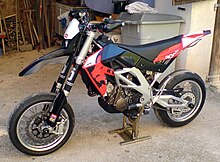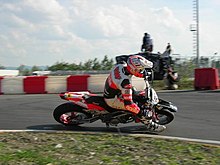Supermoto

Supermoto , originally and commonly used supermotard (French for the English term Superbikers ), originally referred to motorcycles for use on smaller circuits, but now also the racing series held with such machines.
motorcycle
The machines have their origins in the enduro or motocross sector. For use in the Supermoto are usually single-cylinder , rare two-cylinder motorbikes with 125 to 700 cc engine capacity rebuilt. In the late 1980s, the Supermoto movement spilled over from France to the rest of Europe. The Yamaha TDR 250 (1988) and the Gilera Nordcape (later called Nordwest) were among the first mass-produced motorcycles to adopt this style .
The main difference to enduros or motocrossers is the use of road tires or slicks on smaller (17 or 16.5 inches ) and wider (front up to 3.50, rear up to 6.00 inch) rims . Supermotos have a more tightly tuned chassis with shorter springs and more powerful brakes on the front wheel. Often the large off-road mudguards on the front wheel are shortened or made smaller.
Initially, such conversions were undertaken independently. The original aim was not to race the motorcycles, but rather to create an ideal city motorcycle. Enduros are light and manoeuvrable, but the wheels and tires designed for the terrain or at least mixed use restrict handling on roads unnecessarily, while the rather low top speed does not play a role. Starting in Paris, the fashion came up in French cities in the 1980s to use smaller bikes with road tires on enduros and to shorten the mudguards and thus adapt them for city use. Occasionally the chassis has already been equipped with shorter suspension travel.
After supermoto racing established itself internationally, the manufacturers of enduro and motocross motorcycles began to offer variants of their models in special supermoto specifications ex works.
Modern street-legal supermotos are now mostly designed for driving on country roads and mountain passes . This has resulted in changes in the design that clearly differentiate them from converted motocrossers. For example, the suspension travel has become even shorter, the frames are more torsion-resistant, the steering geometry has changed and the motorcycles are better equipped (electric starter, complete cockpit). Also today, supermotos no longer necessarily roll on wire-spoke wheels , but sometimes on cast or forged light alloy wheels.
Today, supermotos are marketed as such by several manufacturers, the best known being KTM , Husqvarna , Aprilia , Ducati , MZ , Husaberg , Suzuki , Yamaha and Honda . Also, BMW offered with the BMW HP2 Mega Moto and the BMW G 650 Xmoto of street-legal Supermotos.
Racing series
Supermoto (often abbreviated to "SuMo") is a comparatively young motorcycle sport that has been practiced in Europe since around 1985. The origin lies u. a. in America, where the supermoto sport originated under the name Superbikers (not to be confused with Superbike ). The idea was to identify the best drivers, ie the “superbikers” , from the three motorcycle sports motocross , road racing and from dirt track or flat track , the American version of the speedway . Therefore, the term supermotard , which is used in other European countries, is actually more appropriate. This comes from France , where the sport has been practiced in the usual form in Germany for several decades. Real SuMo routes have an asphalt, a flat gravel and a hilly off-road section. The asphalt portion is usually 70 to 80%, the off-road portion 20 to 30%.
The fascination of this sport lies in spectacular drifts and overtaking maneuvers. Nevertheless, the injuries from falls in this sport are less serious than in pure road racing or motocross, since the speeds are not as high as with road racing machines and the jumps in the off-road section are not as high or far as in motocross.
Competitions
The competitions are mostly held on outdoor racetracks, often go- kart tracks , which may be converted for supermoto sport (tighter bends, winding, winding passages). Supermoto races are also held in Karthallen. As an off-road component then z. B. a part of an adjacent motocross track or a green strip adjacent to the kart track.
The increasing popularity of supermotos has given rise to numerous new competitions; among them also the German championship . Several brand cups and talent cups have been created to promote the next generation, for example the KTM and ADAC junior cup , as well as the MZ Youngster Cup and the ADMV Drift Cup .
Theoretically, the very loose regulations permit displacements of up to 1200 cm³, against which only the associated high machine weight speaks against. In the world championship there is a distinction between classes S1 and S2 .
The latest development in this area is the Hyper-Moto class. Starting in the 2009 season, Supermoto machines with any number of cylinders and displacements over 600 cm³ will compete against each other on Supermoto circuits as part of the UEM European Championship, but the off-road section will not be driven. With the Aprilia SMV 750 Dorsoduro , the KTM 990 Supermoto , the Ducati Hypermotard and the BMW HP2 Megamoto , suitable series models are already on the market.
World Championship
The FIM -Supermoto-WM is organized by the company Youthstream .
-
- Classes until 2006
- S1 without displacement limit
- S2 to 450 cc
-
- Classes from 2007
- S1 to 450 cc
- S2 from 475 cm³
World Champion
- 2005
- Class S1: Gerald Delepine on Husqvarna
- Class S2: Boris Chambon on KTM
- 2006
- Class S1: Bernd Hiemer on a KTM
- Class S2: Thierry van den Bosch on Aprilia
- 2007
- Class S1: Adrien Chareyre on Husqvarna
- Class S2: Gerald Delepine on Husqvarna
- 2008
- Class S1: Bernd Hiemer on a KTM
- Class S2: Adrien Chareyre on Husqvarna
- 2009
- Class S1: Thierry van den Bosch on TM Racing
- Class S2: Adrien Chareyre on Husqvarna
- 2010
- Class S1: Thomas Chareyre on TM Racing
- 2011
- Class S1: Thomas Chareyre on TM Racing
- 2012
- Class S1: Thomas Chareyre on TM Racing
- 2013
- Class S1: Manou Hermunen on TM Racing
- 2014
- Class S1: Thomas Chareyre on TM Racing
- 2015
- Class S1: Thomas Chareyre on TM Racing
- 2016
- Class S1: Thomas Chareyre on TM Racing
- 2017
- Class S1: Thomas Chareyre on TM Racing
- 2018
- Class S1: Thomas Chareyre on TM Racing
- 2019
- Class S1: Thomas Chareyre on TM Racing
-
2020 - still open- Class S1: Thomas Chareyre on TM Racing or Marc-REiner Schmidt on PHÖNIX - HONDA (L30)
National championships
German championship
- 2006
- Class S1: Petr Vorlicek in a Suzuki
- Class S2: Michael Herrmann on a KTM
- 2007
- Class S1: Petr Vorlicek in a Suzuki
- Class S2: Jochen Jasinski on Husaberg
- 2008
- Class S1: Jürgen Künzel on Husqvarna
- Class S2: Mauno Hermunen on Husqvarna
- 2009
- Class S1: Petr Vorlicek in a Suzuki
- Class S2: Jochen Jasinski on Husaberg
- 2010
- Class S1: Mauno Hermunen on Husqvarna
- Class S2: Michael Herrmann on Husqvarna
- 2016
- Class S1: Andre Plogmann in a Suzuki
- 2017
- Class S1: Markus Class on Husqvarna
Austrian championship
- 2006
- Class S1: Hannes Maxwald on a KTM
- Class S2: Roland Resch on a KTM
- 2007
- Class S1: Jürgen Künzel on a Kawasaki
- Class S2: Hannes Maxwald on a KTM
- 2008
- Class S1: Victor Bolsec on a Honda
- Class S2: Mauno Hermunen on Husqvarna
- 2009
- Class S1: René Esterbauer on a KTM
- Class S2: Andreas Rothbauer on a Honda
- 2010
- Class S1: Victor Bolsec on a Honda
- Class S2 Open: Johann Schruf on Husaberg
- 2011
- Class S1: Hannes Maier on a KTM
- Class S2 Open: Hannes Maier on a KTM
Swiss Championship FMS
- 1998 Prestige Open class: Beat Gautschi on a KTM
- 1999 Prestige Open class: Daniel Müller on a Yamaha
- 2000 Prestige Open class: Marcel Götz on a KTM
- 2001 Prestige Open class: Marcel Götz on a KTM
- 2002 Prestige Open class: Daniel Müller on a Yamaha
- 2003 Prestige Open class: Marcel Götz on a KTM
- 2004 Prestige Open class: Marcel Götz on a KTM
- 2005
- Class Prestige Open S1: Marcel Götz on KTM
- Class Prestige 450 S2: Daniel Müller on a Yamaha
- 2006
- Class Prestige Open S1: Ruedi Herger in a Suzuki
- Class Prestige 450 S2: Daniel Müller on a Yamaha
- 2007 Prestige 450 S2 class: Philippe Dupasquier on a KTM
- 2008 Class Prestige 450 S2: Philippe Dupasquier on a KTM
- 2009 Prestige 450 S2 class: Philippe Dupasquier on a KTM
- 2010 Class Prestige 450: Sylvain Bidart F on a Honda
- 2011 Class Prestige 450: Philippe Dupasquier on a KTM
- 2012 Prestige 450 class: Philippe Dupasquier on a KTM
- 2013 Prestige 450 class: Philippe Dupasquier on a KTM
- 2014 Class Prestige 450: Marc-Reiner Schmidt on a KTM
- 2015 Class Prestige 450: Philippe Dupasquier in a Husqvarna
- 2016 Prestige 450 class: Philippe Dupasquier on Husqvarna
- 2017 Class Prestige 450: Philippe Dupasquier in a Husqvarna
- 2018 Class Prestige 450: Philippe Dupasquier on Husqvarna
Swiss Championship SAM
- 2007 Prestige Open class: Philippe Dupasquier on a KTM
- 2010 Prestige Open class: Philippe Dupasquier on a KTM
- 2011 Prestige Open class: Philippe Dupasquier on a KTM
- 2012 Prestige Open class: Marc-Reiner Schmidt on Zachmann-SUZUKI
- 2013 SAM and FMS championship merged!
equipment
The drivers originally wore motocross / enduro clothing. However, motor racing, which is becoming ever faster, also calls for higher safety measures. Aerodynamics also demands that the Supermoto sport now leather suits (one-piece leather suits inlaid with protectors) are supported. This provides the necessary safety in the event of a fall and represents the least possible surface area for airflow. However, the motocross helmets and boots, which set the Supermoto drivers apart from road racers, remained distinctive. The Leatt brace or neck brace, which is supposed to protect the driver from neck injuries, also ensures safety.
Web links
- Official website of the Supermoto World Championship
- Official website of the IDSM - International German Supermoto Championship
- Supermoto of Nations 2017 - Video of the race
Individual evidence
- ↑ Peter Mayer: Lively bustle . In: motorcycle . No. 09 , 2009, ISSN 0027-237X , p. 37 .




